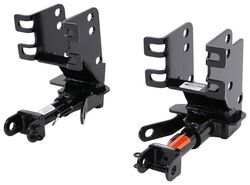
Can 2nd Nut be Added to Roadmaster Base Plate Install of RM-521453-5
Question:
During the baseplate install I used red Loctite on all the fasteners and I appropriately shimmed the baseplate with the ½” flat washers that were included in the kit. While torqueing the upper most bolt position I noticed that the 5” bolt assembly was starting to collapse the Jeep’s square tube frame as I was torqueing the ½” hardware to 56 Lb-Ft. This was happening on both sides even though I had shimmed this mounting location with a ½” flat washer on the frame side of the ½” pipe spacer. When I noticed the frame was starting to collapse, while trying to reach the desired torque specification, I stopped tightening even though I had not yet reached the 56 Lb-Ft specification. FYI, the factory frame hole position that was collapsing was the one we had to drill out to 9/16” prior to installing the baseplate and none of the other mounting positions had any issue and all torqued to the proper spec. Hopefully the use of the red Loctite will prevent this fastener from loosing even though the proper torque was not reached, though I suspect the liquid red Loctite itself may have also acted as an lubricant and may have affected the torque values. Since enough of the ½” bolt threads are exposed on the other side of supplied ½” nut, I plan to add a second ½” nut to essentially double-nut this position to prevent any unwanted loosening. Any thought on this situation?
asked by: James H
Helpful Expert Reply:
There should not be any issue at all regarding adding a second nut when installing the Roadmaster Direct-Connect Base Plate Kit # RM-521453-5.
Regarding the torque values, from what I can see the 1/2" are torqued to 57 ft/lb and you are saying you got to 56? That would seem fine with the double nut, but I need to make very clear that we are not engineers and have no knowledge regarding how torque values are determined.

Product Page this Question was Asked From
Roadmaster Direct-Connect Base Plate Kit - Removable Arms
- Base Plates
- Removable Drawbars
- Twist Lock Attachment
- Roadmaster
more information >
Featured Help Information
Instructions

Continue Researching
- Shop: Base Plate for Tow Bar
- Shop: Vehicle Tow Bar Wiring
- Shop: Roadmaster Direct-Connect Base Plate Kit - Removable Arms
- Shop: Vehicle Tow Bar Brake System
- Shop: Roadmaster Tow Defender Protective Screen for Towed Vehicles
- Video: Roadmaster Direct-Connect Base Plate Kit Installation - 2021 Jeep Wrangler
- Shop: Roadmaster 4-Diode Universal Wiring Kit for Towed Vehicles - 4-Pole Flat Connectors
- Video: Roadmaster Direct-Connect Base Plate Kit Installation - 2020 Jeep Wrangler
- Shop: etrailer Invisible Base Plate Kit - Removable Arms
- Shop: Roadmaster Battery Charge Line Kit for Towed Vehicles
- Q&A: Is Towed Vehicle Battery Charge Kit Needed With Roadmaster Invisibrake
- Shop: Roadmaster Stop Light Switch Kit
- Shop: BrakeBuddy Towed Vehicle Battery Charge Line Kit
- Video: BrakeBuddy Towed Vehicle Battery Charge Kit Review
- Search Results: motorhome mud flaps
- Search Results: brush guard
- Search Results: roadmaster tow defender
- Search Results: rock guard tow protector
- Video: Roadmaster Direct-Connect Base Plate Kit Installation - 2019 Jeep Wrangler
- Q&A: Difference Between Roadmaster Direct-Connect and Crossbar-Style Base Plates for 2020 Jeep Wrangler
- Q&A: Which Rock Guard Fits with Roadmaster Direct Connect Base Plate Kit
- Video: Roadmaster Guardian Rock Guard Road Test
- Video: Roadmaster Tow Defender Protective Screening Installation - 2020 Jeep Cherokee
- Search Results: rm~751490
- Search Results: roadmaster invisibrake
- Video: Roadmaster Stop Light Switch Kit Review RM-751200
- Q&A: Keeping Your Battery Charged While Using The Roadmaster Invisibrake
- Q&A: Troubleshooting a Jeep That Won't Start After Flat Towing
- Q&A: Roadmaster InvisiBrake Battery Charging Capabilities While Flat Towing
- Q&A: Why Would Roadmaster Invisibrake Drain Vehicle Battery





